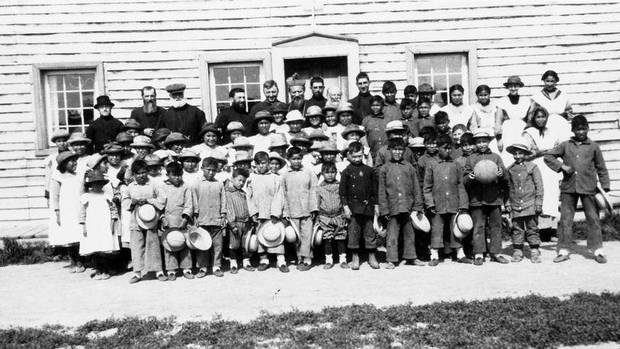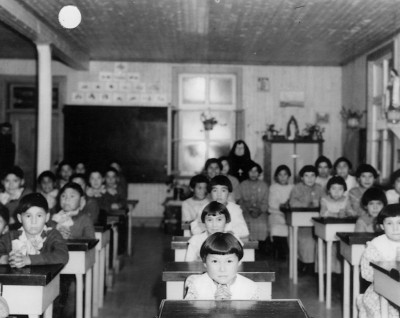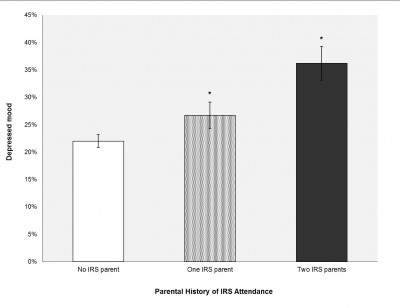
By Parnell Davis MacNevin & Amy Bombay, Department of Psychiatry, Dalhousie University
On Wednesday, June 11 2008, Prime Minister Stephan Harper stepped up to a podium in Ottawa and delivered a long overdue speech. In this speech he acknowledged and apologized for the wrongdoings Canada openly committed against Aboriginal peoples for over 100 years through the Indian Residential School system, which ran from the mid-1800s until the decommissioning of the last school in 1996. During this time, generations of Aboriginal children were forcibly removed from their homes, made wards of the state, and placed in under funded, government church-run schools aimed at assimilation. These schools taught children to be ashamed of their languages, cultural beliefs and traditions, and many were victims of chronic mental, physical, and sexual abuse.
Not surprisingly, Residential School Survivors are at greater risk for various health and social issues compared to Aboriginal adults whose families were not affected by these schools (Elias et al., 2012). Apologies have been made, and now government funding for healing and wellness programs for Survivors has run dry, the Aboriginal Healing Foundation has officially closed (September 30, 2014), and the Truth and Reconciliation Commission of Canada is about to submit its final report and have its final gathering in June 2015. But will the legacy of the Residential Schools end with the last generation of Survivors, or are these experiences continuing to have negative effects on subsequent generations?
 The intergenerational effects of Residential Schools have long been acknowledged through anecdotal evidence and personal accounts, but there had been very little empirical research documenting these effects until the last 5 years. Amy Bombay, an Ojibway (Rainy River First Nation) researcher and Assistant Professor at Dalhousie University, has been working in collaboration with Kimberly Matheson and Hymie Anisman at Carleton University to address this gap in a series of studies exploring how trauma is transmitted through Indigenous families. Consistent with intergenerational effects reported in previous qualitative accounts, quantitative analyses revealed that the adverse psychological effects of the Indian Residential Schools are not limited to Survivors, but also extend to subsequent generations (Bombay, Matheson, & Anisman, 2014).
The intergenerational effects of Residential Schools have long been acknowledged through anecdotal evidence and personal accounts, but there had been very little empirical research documenting these effects until the last 5 years. Amy Bombay, an Ojibway (Rainy River First Nation) researcher and Assistant Professor at Dalhousie University, has been working in collaboration with Kimberly Matheson and Hymie Anisman at Carleton University to address this gap in a series of studies exploring how trauma is transmitted through Indigenous families. Consistent with intergenerational effects reported in previous qualitative accounts, quantitative analyses revealed that the adverse psychological effects of the Indian Residential Schools are not limited to Survivors, but also extend to subsequent generations (Bombay, Matheson, & Anisman, 2014).
First Nations youth who have a parent who is a Residential School Survivor are more likelty to report depressed mood than those whose parents did not attend. Also, First Nations adults from families in which multiple generations attended Residential Schools (i.e. parents and grandparents) are particularly high risk for experiencing psychological distress and these intergenerational effects often manifest before adulthood (Bombay et al., 2011). This latter finding is important because it provides evidence that the consequences of collectively experienced traumatic events can carry forward and accumulate through generations to influence well-being. The existence of this link between past government policies and continued disparities underlines government’s responsibility to implement new policies that aim to eliminate the increased risk for health and social problems faced by Aboriginal peoples.
 This program of research also set out to answer the question of why children of Survivors are at greater risk for negative health outcomes. Bombay and her colleagues identified stress proliferation as playing a role in the chronic exposure to stressors reported by many Residential School offspring, which is the process by which an initial challenge or adverse experience gives rise to additional stressors (Bombay et al., 2011). In general, the children of Survivors report encountering stressors during childhood (e.g., abuse, neglect, witnessing household violence, parental substance abuse), and throughout their adulthood this increased exposure to early life stressors was predictive of higher depressive symptoms (Bombay et al., 2011).
This program of research also set out to answer the question of why children of Survivors are at greater risk for negative health outcomes. Bombay and her colleagues identified stress proliferation as playing a role in the chronic exposure to stressors reported by many Residential School offspring, which is the process by which an initial challenge or adverse experience gives rise to additional stressors (Bombay et al., 2011). In general, the children of Survivors report encountering stressors during childhood (e.g., abuse, neglect, witnessing household violence, parental substance abuse), and throughout their adulthood this increased exposure to early life stressors was predictive of higher depressive symptoms (Bombay et al., 2011).

Aboriginal War Veterans monument. Photo by Padraic Ryan
Culture and identity are important determinants of well-being, and are particularly strong predictors of health among Aboriginal populations (McIvor, Napoleon, & Dickie, 2009). For example, having cultural pride buffers against the negative impacts of discrimination. On the other hand, those who consider their heritage to be an important aspect of their self-concept appear to perceive greater levels of discrimination.
Here again, when looking at identity, we can see that past collectively experienced trauma can evoke greater vulnerability to negative outcomes, as children of Residential School survivors were more likely to consider their heritage as central to their identity. Although having high identity centrality can be protective when combined with cultural pride, the higher levels of identity centrality reported by children of Survivors was associated with increased likelihood of attributing negative encounters with non-Aboriginal people to discrimination and to appraising them as threatening to their well-being (Bombay et al., 2013). These findings highlight that culture-related factors are involved in the intergenerational transmission of collective trauma and in contributing to group-based health and social disparities.
In general, the legacy of the Residential School system continues to negatively affect today’s Indigenous population in Canada, and appears to put those who have been intergenerationally affected at risk for a trajectory that leads to poor well-being. There are many factors that contribute to this; stress proliferation, increased perceived discrimination, increased stressor encounters and sensitivity to the negative effects of stressors, but the question remains: How can we improve these outcomes? There is continued need to recognize and raise awareness about the intergenerational impacts of the Indian Residential Schools. Learning about the continuing impacts may help all Canadians to understand the complicated social factors contributing to the health of Indigenous peoples, and highlight the need for governmental and social accountability with regard to the legacy of the Indian Residential School system and other historical and contemporary forms of marginalization and systemic discrimination.
References
Bombay, A., Matheson, K., & Anisman, H. (2013). Appraisals of discriminatory events among adult offspring of Indian Residential School Survivors: The Influences of Identity Centrality and Past Perceptions of Discrimination. Cultural Diversity and Ethnic Minority Psychology, 20(1), 75-86.
Bombay, A., Matheson, K., & Anisman, H. (2013). Expectations among Aboriginal Peoples in Canada Regarding the Potential Impacts of a Government Apology. Political Psychology, 34(3), 443-460.
Bombay, A., Matheson, K., & Anisman, H. (2011). The impact of stressors on second generation Indian Residential School Survivors. Transcultural Psychiatry, 48(4), 367-391.
Bombay, A., Matheson, K., & Anisman, H. (2010). Decomposing identity: Differential relationships between several aspects of ethnic identity and the negative effects of perceived discrimination among First Nations adults in Canada. Cultural Diversity and Ethnic Minority Psychology, 16(4), 507-516.
Elias, B., Mignone, J., Hall, M., Hong, S., Hart, L., & Sareen, J. (2012). Trauma and suicide behaivour histories among a Canadian indigenous population: An empirical exploration of the potential role of Canada’s residential school system. Social Science & Medicine, 74, 1560-1569.
McIvor, O., Napoleon, A., & Dickie, K. (2009). Language and culture as protective factors for at-risk communities. Journal of Aboriginal Health, 5(1), 6-25.